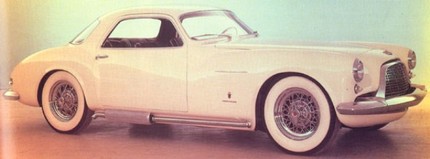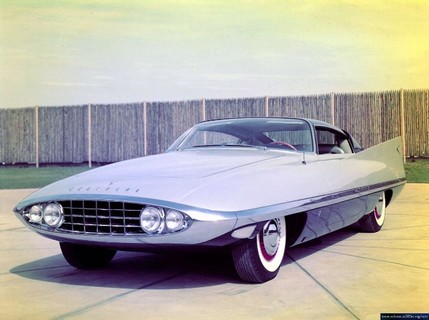
Chrysler displayed several of their concepts during a gala at the Walter P. Chrysler Museum. Chrysler Photo.
Concept cars have always been a big part of the auto industry. Whether they foreshadow an upcoming model, highlight various ideas that might make it into production, or just feature over-the-top elements just because the automaker can, they have been wowing the public for more than 70 years.
One of the early pioneers of the concept car trend was the Chrysler Corporation. Chrysler was steeped in design history from the very beginning. From the lavish, Art Deco Chrysler Building in New York City that was commissioned by Walter P. Chrysler himself and opened in 1930, to the ultra-streamlined Chrysler and Desoto Airflow cars of 1934 – 1937, Chrysler was always looking for new ways to push the design envelope.
The 1938 Buick Y-Job, designed by Harley Earl at rival General Motors, sparked the concept car craze.
Chrysler quickly answered the call with the 1940 Thunderbolt Concept. The Thunderbolt was designed by Alex Tremulis, the same guy that came up with the space-aged Tucker a few years later, and LeBaron designer Ralph Roberts. Like the Airflows, the Thunderbolt was extremely streamlined, with no running boards, and skirts covering the wheels. Unlike the large Airflows, the Thunderbolt was a sporty, two-seat roadster. It featured a retractable hardtop, something that hasn’t really been available on a production two-seat sports car until very recently. Six Thunderbolts were actually produced on Chrysler New Yorker chassis, and four of them are still extant today.
Then, right as the Thunderbolts were getting some attention—bang!—along comes the Chrysler Newport Concept. And they built six of those, too, giving Chrysler twelve shiny, new concept cars to travel around and dazzle people. That’s a lot, considering that GM, the dream car pioneer, only had the one Y-Job.
Tremulis and Roberts designed the Newport as well. This one, also built on an Imperial chassis, featured a classic dual-cowl design with flowing side panels. One of them even paced the 1941 Indianapolis 500.
The Thunderbolts and Newports marked a pretty exciting time in Chrysler concept car history, but the snowball was really growing in 1949 when Chrysler president K.T. Keller hired Virgil Exner.
Exner had on-the-job training by the most influential stylists of his day. He had worked for Harley Earl at General Motors in the 1930s, and moved on to work under the great designer Raymond Loewry at Studebaker by the late ‘30s/early ‘40s.
Exner hired on at Chrysler as part of the Advanced Styling Group. In spite of breakthrough vehicles like the Airflows and the early concept cars, most Chrysler Corporation production vehicles were pretty stodgy. They were tall; they were narrow; they were generic. Exner set out to change that.
Luigi Segre of the Italian design house Carrozzeria Ghia became good friends with Exner, and their relationship resulted in several Ghia-bodied concept cars.
Known as “Idea Cars” in Chrysler circles, these Italian beauties enhanced Chrysler’s image with their low, racy lines and features like intricate wire wheels. Some of these cars actually made it into limited production, and were owned by the likes of Frank Sinatra and Dean Martin.
Exner also transformed Chrysler’s production lineup, producing the “Forward Look” of the late 1950s with impossibly low rooflines and radically stylized fins.
Chrysler produces memorable concept cars to this day. But some of the most beautiful, and most usable cars came from the early days of dream car design.

1940 Chrysler Thunderbolt Concept. This radical two-seater was Chrysler’s first concept. It featured a retractable roof among its many features. Six were produced for show purposes; four exist today. Chrysler Photo.

1941 Chrysler Newport Concept. The Newport was a sister car to the Thunderbolt. Six of these were also produced, and one was used to pace the 1941 Indianapolis 500.

1952 Chrysler K-310 Concept. This was the first Chrysler concept designed by Virgil Exner and built by Ghia. The “K” was for Chrysler’s president, K.T. Keller. And the 310 was the horsepower of the 331-c.i. Hemi under the hood. Chrysler Photo.

1953 Chrysler D’Elegance Concept. This attractive coupe had many of the same styling cues as some of the other Ghia concepts, but the design of the top actually lived on in later years when Ghia applied it to the Volkswagen Karmann Ghia. Chrysler Photo.

1953 Dodge Firearrow Concept. This was the first of a series of Firearrow concepts built on Dodge chassis. This first car was more like a full-sized mockup than a real car, but subsequent Firearrows had the ablity to run and drive. Chrysler Photo.

1953 Chrysler Special Concept. Six Ghia concept cars were built in 1953, including this Pininfarina-bodied Chrysler Special. These high-body, low-top coupes were occasionally seen being driven by high-level Chrysler executives. Chrysler Photo.

1954 Desoto Adventurer Concept. These are usually considered Chrysler’s response to the Chevrolet Corvette. It nearly made it into production, but company infighting resulted in an end to the project. Chrysler Photo.

1954 Firearrow II Concept. This was similar to the original Exner-designed Firearrow, except this one could be driven. The frameless windshield was quite a sensation. This car was sold at the Barrett-Jackson collector car auction in Arizona last year for $1.1-million before a live, national TV audience. Chrysler Photo.

1955 Chrysler Falcon Concept. The timing of this concept leads people to believe that it may have been considered as a production car to compete with the Ford Thunderbird. If the well-proportioned Falcon had made it, those exposed exhaust side pipes would have been pretty radical for the time. Chrysler Photo.

1955 Desoto Adventurer II Concept. This long, cigar-shaped concept was fairly radical for production consideration, but it did showcase the styling talents of Exner and his team. Chrysler Photo.

1955 Desoto Flight Sweep Concept. In this photo, you can see Exner and his team with the ’55 Desoto Flight Sweep. This concept is significant, because it first explored the use of tailfins, a design element that would become very prevalent in Chrysler Corporation production cars. Chrysler Photo.

1955 Desoto Flight Sweep Concept. Here is the car in the last picture out in the open. There was also a closed-top version developed called the Fire Sweep. Chrysler Photo.

1956 Chrysler Plainsman Concept. Station wagons might not have the sex appeal of some of the two-seat roadsters we’ve looked at here, but in the ‘50s, they were the ride de jour for people with families. The original-condition Plainsman is expected to sell at the RM classic car auction in Arizona in January. Chrysler Photo.

1956 Chrysler Norseman Concept. The exact location of the Norseman is known today, and yet, there are very few pictures of this car. Reason being, after it was finished by Ghia in Italy, it was loaded in the cargo hold of the ill-fated Andrea Dora luxury ship, headed back to the U.S. The Norseman is still resting at the bottom of the ocean, as it will be until the salt water completely claims it. Chrysler Photo.

1956 Dodge Dual Ghia. This car is interesting, because it wasn't exactly Chrysler's work, per se. Eugene Casaroll, transport coordinator, purchased the original Chrysler Firearrow concept and reworked it. His plan was to form Ghia Motors and sell 150 of these a year. Celebrities like Frank Sinatra owned Dual Ghias. In the end, only 117 Dual Ghias were built between 1956 and 1958. These cars are highly collectable today. Chrysler Photo.

1956 Dodge Dart Concept. What started out as the Dart became the Diablo concept after Exner tweaked it for the 1957 show circuit. The owner of the Diablo attempted to sell it at the RM classic car auction in Monterey, Calif., last year, but it failed to hit its reserve even after hitting $1.2-million. Chrysler Photo.

1958 Imperial D'Elegance Concept. Virgil Exner didn't really like this concept, and let's face it, it is easy to see why. Nonetheless, several design features did make it to production cars within the next few years. They just weren't all combined together. Chrysler Photo.

1960 Plymouth XNR Concept. XNR is another way to spell “Exner”, and certainly the XNR concept was one of his most radical. Built on the compact Valiant platform, the asymmetrical XNR looked more like a Barris Kustom than a factory concept car. As it turns out, the original Ford Mustang concept was a two-seat sports car built on the compact Ford Falcon chassis. Interesting how things ran in cycles. Chrysler Photo.

1961 Chrysler Turboflyte Concept. This was Virgil Exner's last Idea Car for Chrysler. With the glass canopy, it looked like something from Darryl Starbird's custom shop, but it was loaded with features. Most notable was the “wing” that connected the large tailfins. It was just for looks then, but eventually, that idea was put to solid aerodynamic use with the Plymouth Superbirds in 1970. Chrysler Photo.

1963 Chrysler Turbine. These Ghia-bodied coupes were meant to test turbine engine technology. 200 customers were given the opportunity to use these cars for day-to-day commuting. Unfortunately, they used lots of fuel, and they were quite expensive to maintain. 44 of the 50 cars were scrapped; the remaining six were commissioned for museum duty. Chrysler Photo.
Source: Examiner!
For more stories and vintage photographs on early concept cars, also see:
General Motors Concept Cars:
General Motors concept cars were produced when anything was possible. Motorama. Parade of Progress.
Ford Concept Cars:
Ford concept cars of the 1950s/'60s foreshadowed a George Jetson-like, space-aged world.